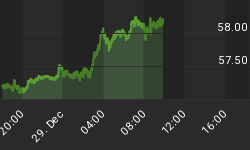
![]() Larger Image - Source: www.sharelynx.com
Larger Image - Source: www.sharelynx.com
When one thinks of gold it is usually always in terms of US$. Everyone has been conditioned to think that way. But if you live in Canada you most likely pay for your gold in Cdn$ not US$. For the most part one would make their gold purchase in the local currency. The above chart is not any particular local currency. Above is a gold index expressed in a basket of local currencies. This particular index does not weight the currencies. It is an equal weighted index of currencies of the top 20 countries by GDP. The chart is prepared by Nick Laird of www.sharelynx.com. Nick has also created a weighted index of the top 20 countries by GDP, however, at time of publication Nick was correcting some errors in the data.
The index is created the same as one would create the TSX Composite or the Dow Jones Industrials or for that matter the Gold Bugs Index (HUI). The index can be compared to gold in US$. Some differences do stand out.

Charts created using Omega TradeStation 2000i. Chart data supplied by Dial Data
One of the most notable differences between the non-weighted gold currency index and gold in US$ is that unlike gold in US$ the non-weighted gold currency index kept rising in the late 1990's. Not only that while gold in US$ was making a double bottom in 1999 and 2001 the non-weighted gold currency index made a higher low in 2001. What this is suggesting is that while gold prices may have been falling in US$ it was most likely rising for at least some of the currencies thus pulling the non-weighted gold currency index to the upside.
Another interesting divergence showed up in 2011 and 2012. Gold in US$ made its top in 2011 and in 2012 it made a lower top. On the other hand, the non-weighted gold currency index made a double top in 2012 with the 2011 top. Since then gold has been falling and given the drop in the non-weighted gold currency index, gold appears to be have been falling in all currencies.
But gold has not fallen equally in all currencies. Gold in US$ is roughly down 34% from its 2011 top. The gold non-weighted currency index is, however, only down roughly 23%. That is a considerable difference. It appears that gold has fared much better in some currencies then it has in US$. In Cdn$ for example gold is only down 27% from its 2011 top. In Euros and Swiss Francs, gold is down 29% but it is only down 14% in Japanese Yen. In British Pounds, gold is down 34% but in Russian Rubles, gold is down 20% from its top.
That gold has corrected in all currencies since the 2011 top is no surprise. That it has corrected less in some currencies as these charts appear to indicate may be the real surprise. The reality for gold, however, is that in order for it rise it must be rising in all currencies. Gold will always be rising in some currencies even as it is falling in others. There will always be periods of corrections. But for a real major rally to get underway for gold it should be rising in all currencies not just a few.
If gold, should happen to breakdown and make new lows below US$1,180 the key might to watch for divergences with other currencies. Or watch for divergences in the non-weighted gold currency index such as was seen at the 1999 and 2001 low and even at the 2011 and 2012 tops. Significant divergences might be signaling that the three-year gold correction is over.
















